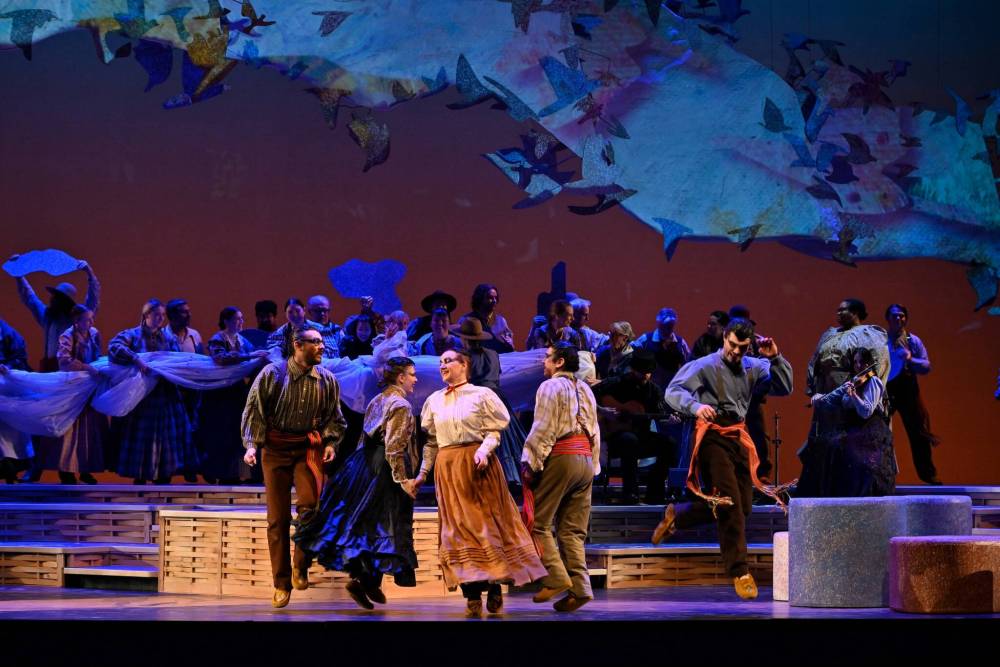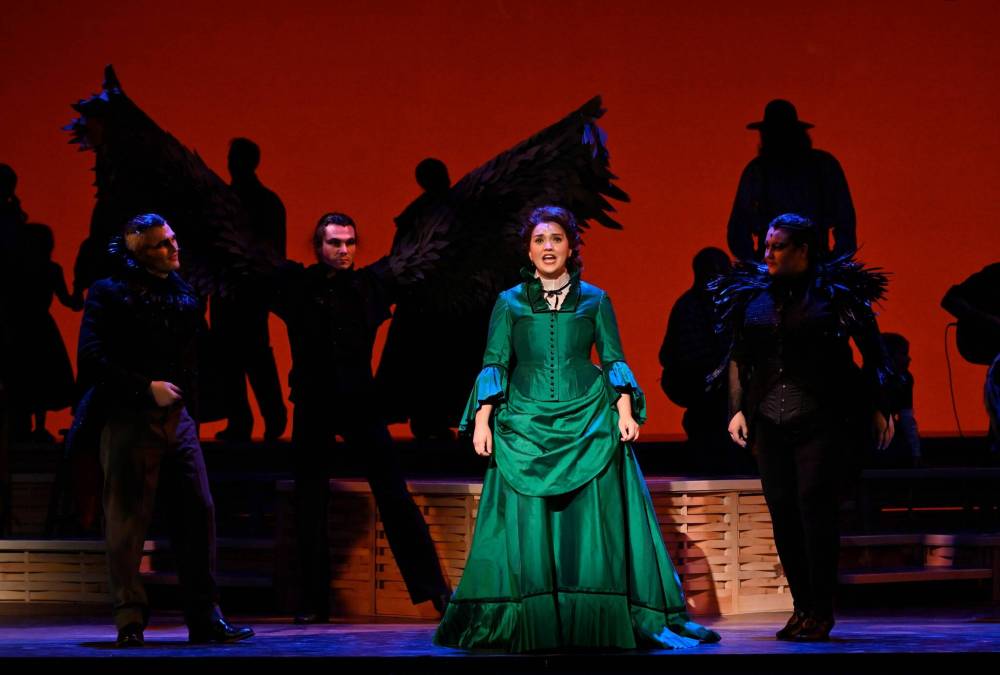Poetry meets power in groundbreaking new opera
Advertisement
Read this article for free:
or
Already have an account? Log in here »
To continue reading, please subscribe:
Monthly Digital Subscription
$1 per week for 24 weeks*
- Enjoy unlimited reading on winnipegfreepress.com
- Read the E-Edition, our digital replica newspaper
- Access News Break, our award-winning app
- Play interactive puzzles
*Billed as $4.00 plus GST every four weeks. After 24 weeks, price increases to the regular rate of $19.00 plus GST every four weeks. Offer available to new and qualified returning subscribers only. Cancel any time.
Monthly Digital Subscription
$4.75/week*
- Enjoy unlimited reading on winnipegfreepress.com
- Read the E-Edition, our digital replica newspaper
- Access News Break, our award-winning app
- Play interactive puzzles
*Billed as $19 plus GST every four weeks. Cancel any time.
To continue reading, please subscribe:
Add Free Press access to your Brandon Sun subscription for only an additional
$1 for the first 4 weeks*
*Your next subscription payment will increase by $1.00 and you will be charged $16.99 plus GST for four weeks. After four weeks, your payment will increase to $23.99 plus GST every four weeks.
Read unlimited articles for free today:
or
Already have an account? Log in here »
Hey there, time traveller!
This article was published 19/11/2023 (705 days ago), so information in it may no longer be current.
Li Keur: Riel’s Heart of the North is based on a libretto by Vancouver-based Métis poet/storyteller Suzanne Steele, and co-composed by Métis fiddler Alex Kusturok and Canadian Mennonite University music prof Neil Weisensel.
The 135-minute (including intermission) production, sensitively directed by Winnipeg’s Simon Miron, is a love letter to the Métis nation, as well as a joyous celebration of its women and culture.
Opera review
Li Keur: Riel’s Heart of the North
Manitoba Opera
Centennial Concert Hall
Saturday, Nov. 18
4.5 out of five
It’s also a fascinating showcase for Indigenous heritage languages, with its cast of 11 principals and adult/children choruses seamlessly slipping among five languages — Southern Michif, French-Michif, Anishinaabemowin, French and English — with English surtitles provided throughout.
The highly imagistic, poetic narrative, which moves from 1870s Montana through to the 21st century, unfolds through a series of dream-like sequences. The plot centres on Josephine-Marie (local actor Charlene Van Buekenhout), a feisty, modern-day Métisse university student struggling with an essay on decolonization and self-location.
She declares early on to her beloved Mémère (actor Paulette Duguay) that she doesn’t want to “carry the burdens of our nation.”
“I pass for ‘white’ and that makes everything so much easier,” she says.
ROBERT TINKER PHOTO Rebecca Cuddy (left) as Métisse sharpshooter Josette and Keely McPeek as her friend, knowledge keeper Marie Serpente
She also rails against the legacy of Métis leader Louis Riel; librettist Steele immediately addresses the generations-old controversy that still swirls around the visionary maverick now recognized as the father of Manitoba.
There are many compelling moments ringing with truth in this show, its cast of characters brought to life by singers, actors, dancers and musicians who have these stories in their blood and bones.
Mezzo-soprano Rebecca Cuddy crafts young Métisse sharpshooter Josette La Grande, who falls hard for Riel — disguised as “Baptiste Robideau,” on the run from assassins — as a fiercely independent heroine in search of own destiny, after her father, Pierre La Grande (bass-baritone David Watson) sells her as chattel to crusty fur trader Jacques La Crosse (tenor James McLennan).
ROBERT TINKER PHOTO Manitoba Opera’s Li Keur features a huge cast that includes actors, singers and dancers to bring Métis history to life.
Audible gasps came from the audience when Anishinaabe lyric baritone Evan Korbut — a dead ringer for the young Riel — first appeared, bringing the leader back to life mere days after the 138th anniversary of his execution on Nov. 16, 1885, and ramping up the opera’s ghostly overtones.
His opening aria, in which he sings, “O Spirit of God, give me the guts of the North,” showed off his robust vocals and well-nuanced characterization.
Soprano Keely McPeek delivered a fine performance as Marie Serpente, Josette’s childhood friend/confidante who joins her with her own lover and Riel’s guide partner, tenor Nolan Kehler’s La Roche. Her administering to the fallen as a knowledge keeper and medicine woman is emblematic of the power and wisdom of women to heal the deep wounds of the world, with McPeek’s sensitive portrayal providing gravitas.
The Black Geese of Fate (mezzo-soprano Michelle Lafferty and tenor Scott Rumble) serve as the opera’s chief protagonists, swooping into Riel’s life as agents of change. These dramatic figures, flanked by a six-member Black Geese dance ensemble, might have played a darker, more intense role as they propel the storyline forward.
ROBERT TINKER PHOTO Julie Lumsden (centre) plays Louis Riel’s wife Marguerite, with, from left, Scott Rumble (Black Goose 2), Jera Wolfe, dancer, Michelle Lafferty (Black Goose 1).
One must mention Canadian dance artist’s Jera Wolfe’s gorgeous duet, including daring lifts with local contemporary dancer Elise Page, which mirrored the two lead characters as Josette sings of her passion for Riel/Robideau.
The versatile McLennan also appeared as an “Englishman” who lusts after Josette and wishes to possess her. His over-the-top portrayal, teetering on stereotype, symbolizes dark colonial forces in this country that sought to whitewash Indigenous culture and identity.
An abundance of spoken narration/dialogue in lieu of typically sung recitative, while helpful in clarifying shifts between vignettes, diffuses the opera’s dramatic tension. Some scenes could also be whittled or cut entirely to help sharpen the narrative’s focus.
However, more jigging is always welcome; the dancers lit up the stage with pure joy during their every appearance, accompanied by the live Black Geese band of Kusturok, fiddler Melissa St. Goddard and guitarist Jordan McConnell.
Weisensel skilfully led the Winnipeg Symphony Orchestra through his orchestral score, featuring a contemporary vernacular of musical language that is strong and sure, though at times suffering touches of melodrama.
It’s at its lyrical best during such poignant arias as Josette’s Beneath the endless azure sky or You come and go, sung to Riel, with many pieces that could easily become stand-alone concert works.
Steele’s lexicon is unabashedly poetic, conjuring evocative images such as windflowers scattering in the wind as a metaphor for Métis peoples forced to disperse throughout the diaspora.
The show’s dénouement, in which Josephine-Marie takes full ownership of her Michif heritage, in tandem with Josette’s inheriting symbolic gifts as Riel is sentenced to die, could be fleshed out more fully.
However, the entire multi-generational cast triumphantly singing “We are the guts and the heart of the North” is powerfully moving.
The $1.2-million dollar production boasts a striking set of a Métis infinity symbol with risers (only completely visible from the hall’s upper balconies and loges) designed by T. Erin Gruber, who also created animated digital projections including geese, dragonflies, beadwork and bison. The period is captured by Deanne Finnman’s traditional costumes; Scott Henderson’s lighting is at times too dim.
In addition to celebrating Michif culture, Li Keur more largely marks a pivotal step forward in the ongoing journey of reconciliation with Canada’s Indigenous Peoples. Many in opening night’s sold-out, mixed-age audience were likely witnessing this historically Euro-centric art form for their first time, while seeing themselves mirrored onstage by opera singers wearing moccasins, Métis sashes and buckskin jackets. As expected, the enthralled crowd leapt to its feet at the end as the full stage of performers burst into a jig.
Li Keur marks a seminal point in time that reverberates with the Black Geese’s Act I imperative to Riel: “The future is now.”
Li Keur: Riel’s Heart of the North repeats on Wednesday, Nov. 22, at 7 p.m. and Friday, Nov. 24, at 7:30 p.m.
holly.harris@shaw.ca
History
Updated on Monday, November 20, 2023 5:08 PM CST: Clarifies reference
Updated on Thursday, November 23, 2023 4:18 PM CST: Removed repeated para
Updated on Thursday, November 23, 2023 4:22 PM CST: Added related post


